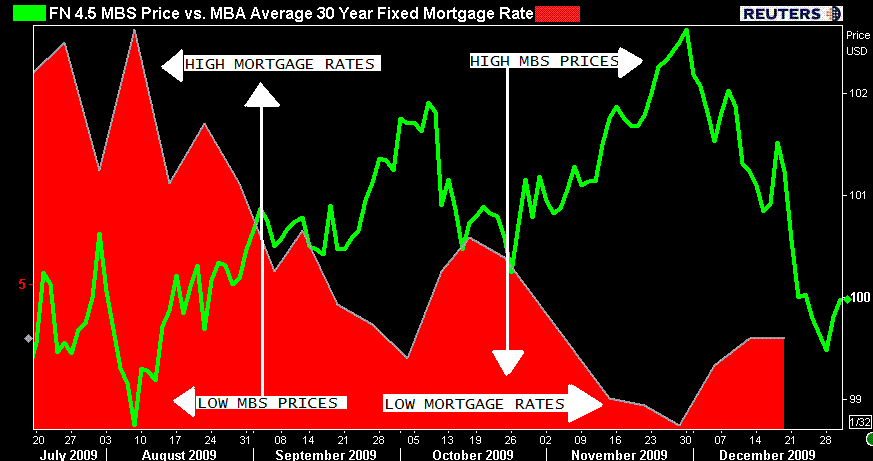Although prices of mortgage backed securities moved higher yesterday, lenders were unwilling to move mortgage rates lower. This was a frustrating event for most originators and borrowers who were expecting to see at least modest improvements in the primary market (mortgage rates) as the secondary market (MBS trading) rallied. While a few lenders repriced for the better towards the end of the day, the gains were weak. As a reminder, as MBS prices rally, lenders are able to offer lower mortgage rates. I like to use the below chart to illustrate the inverse relationship.
MBS prices are in green and mortgage rates are in red. Remember as MBS prices rise, mortgage rates fall.

Do you see the relationship? :-D
The market absorbed two economic reports this morning.
First, the U.S. Department of Commerce released the Factory Orders report. This data represents the dollar amount of new orders made for both durable and non-durable goods.
Durable Goods are products that have a life expectancy of at least three years (cars, computers, machinery). Non-durable goods are products that can only be used one time OR a product with a life span of less than three years. Nondurable goods make up about half of Factory orders so this data, although on a two month lag, can have some influence on the marketplace. If orders are increasing, it would indicate factories will be busier in the months ahead. Busier factories could lead to additional jobs which is good for the overall economy and the equities markets.
October’s report indicated factory orders increased 0.6%. Economists surveyed expected November’s orders to post another increase of 0.5%. Forecasts were right to be optimistic, but they were not optimistic enough! The report indicated factory orders improved much more than expected by 1.1%. October’s report was revised higher to an 0.8% increase too.
The second release was more relevant to housing professionals: The Pending Home Sales Index
In October, the Pending Home Sales Index, increased 3.7 percent to 114.1 from 110.0 in September. This was 31.8 percent above October 2008 when it was 86.6. The year over year expansion was the biggest annual increase ever recorded for the index.
In the data released today, which reported on contract activity in November, the pending home sales index fell more than expected to 96.0 from a revised higher read of 114.3 in October. This was a 16.0 percent decline, much worse than the 2.0 percent contraction economists had forecast.
AQ wrote an in-detail analysis of the housing market data and discussed expected trends. MUST READ
Reports from fellow mortgage professionals do indicate lender rate sheets to be improved from yesterday. The par 30 year conventional rate mortgage has fallen back to the 4.875% to 5.125% range for well qualified consumers. To secure a par interest rate you must have a FICO credit score of 740 or higher, a loan to value at 80% or less and pay all closing costs including an estimated one point loan origination/discount/broker fee. You may elect to pay less in closing costs but you will have to accept a higher interest rate.
MBS prices have been moving higher throughout the day so some lenders may reprice for the better. That said I recommend floating UNTIL THE END OF THE DAY to give lenders a chance to reprice for the better.
Yes just until the end of the day. Looking forward we have a major economic event on the horizon: NON FARM PAYROLLS. This is the grand daddy of 'em all in terms of economic data. This is the Employment Situation Report. Last month the economy saw the fewest amount of job losses since December 2007, when the recession officially began. Adding more optimism were revisions to the previous two reports. The October NFP job loss number was cut from -190,000 to -111,000 and the September report was trimmed from -219,000 to -139,000. That is 159,000 less job cuts!
After the December jobs report, mortgage rates rose all the way into the new year. This month the market is expecting more positivities from the labor market. If these forecasts are accurate, the bond market will not react well and mortgage rates will move higher. The reason I recommend floating UNTIL THE END OF THE DAY is because tomorrow the ADP Employment Report is released. This is a pre-cursor to Friday's NFP report. If tomorrow's ADP report implies the labor market is continuing to improve...mortgage rates will rise.
While a corrective rally would likely ensue if labor market data is worse than expected, floating is a very risky move. With that in mind I would recommend locking. There is much to lose if the jobs report is as expected. It would essentially confirm the month long trend of rising rates we dealt with in December. This would put a firm level of resistance under mortgage rates, making lower rates even more unlikely in the future.
Current market mortgage rates are still aggressive, locking is the safe move ahead of these major reports. If you are feeling risky, float into tomorrow. You will get an idea of how the market reacts to labor market data in the morning when ADP is released. The market expects -73,000 lost jobs in the private sector. Compare that to last month's read of -169,000 jobs.
AQ expands on this outlook. READ MORE




